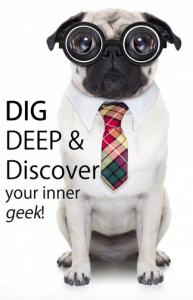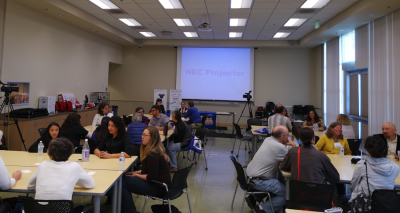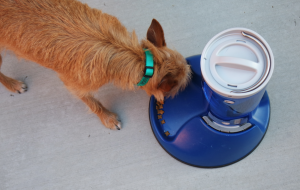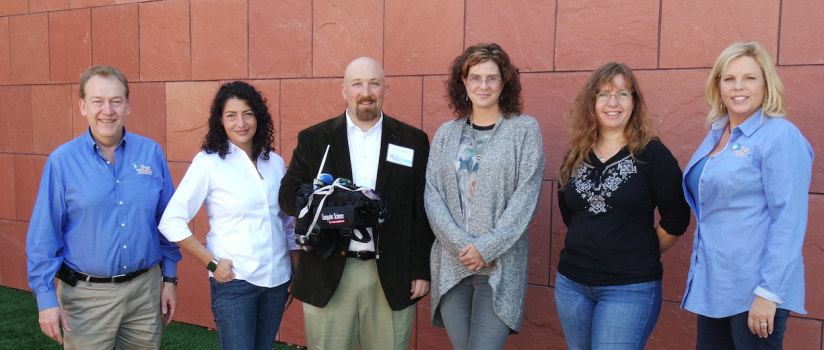 Just 10 years ago, who would of thought we could hold an entire conference on technology in the pet industry? We have crossed the Rubicon earlier this month in Silicon Valley, home of many of the largest technology corporations. Innovations from Apple, Google, Amazon, Youtube, Facebook, Sony, etc. have changed the way we interact with technology. The digital revolution, permeating every aspect of our lives is now also challenging the status quo in the pet industry and forces us to rethink the way we play, train and communicate with our pets. As owners we have options that we never had dreamed before. Pet professionals have to stay on top of never-ending advances, constantly re-examining what skills they must master and what type of products and services they must offer to stay competitive. At the Humane Society of Milpitas, CA, close to a hundred animal lovers gathered to learn about how pet technology might change how we work and interact with animals.
Just 10 years ago, who would of thought we could hold an entire conference on technology in the pet industry? We have crossed the Rubicon earlier this month in Silicon Valley, home of many of the largest technology corporations. Innovations from Apple, Google, Amazon, Youtube, Facebook, Sony, etc. have changed the way we interact with technology. The digital revolution, permeating every aspect of our lives is now also challenging the status quo in the pet industry and forces us to rethink the way we play, train and communicate with our pets. As owners we have options that we never had dreamed before. Pet professionals have to stay on top of never-ending advances, constantly re-examining what skills they must master and what type of products and services they must offer to stay competitive. At the Humane Society of Milpitas, CA, close to a hundred animal lovers gathered to learn about how pet technology might change how we work and interact with animals.
The morning kicked off with an emphasis on coaching people. When dog guardians seek the help of a dog trainer, they come with a certain belief system on dogs, but also with a number of motor habits that can sometimes be difficult to unlearn. As Bob Bailey often repeats: “training is a mechanical skill”. Timing, delivering the treats, holding the leash and the clicker, moving at a certain pace, talking with a certain tone of voice, all affect how effective we are with an animal. And as the late and wonderful Sophia Yin so rightfully pointed out, animal training is like a sport. In coaching people in different sports, most coaches today rely on video to provide constructive and objective feedback. There’s an app for that! Coach’s Eye for instance, has been specifically designed to coach people in the development of their motor skills through the use of video. As trainers, we can use those apps to help us with our clients. The big advantages: video allows the guardians to watch themselves and to watch their dog. It’s very difficult for anybody to try to master a new set of skills while also paying attention to the many details of a situation. They might fail to notice that their arm tightens or that they bend over anytime they ask for a ‘down’. Most importantly, they might not notice a quick yawn, a turn of the head or the lip licking of their dog. Video allows us to play back certain sequences, to slow down important yet subtle changes, and to point out to specific aspects of a movement. Most of all, video, allows the guardian to be an active participant in the process through open conversations about the video sequence.
Technology can also enhance the way trainers can learn how to perfect their own skills. In her presentation, Jean Donaldson, Ph.D., described in great detail how technology allows her to help trainers broaden their knowledge on dog behavior and develop their motor skills. She created an online course that allows people to learn how to become a dog trainer, from all over the world without compromising on the content. Her two year certification program offers a heavy curriculum through a series of teachings, assignments, quizzes, webinars, case monitoring and more. With the software Articulate, she can create interactive online courses. With Moodle, another software, Donaldson provides her students with community forums, where cases can be discussed and ideas exchanged. Students can share videos and get constructive feedback from Donaldson and her graduates. Through the smart application of modern technology, her program offers an innovative and modern approach to teaching professionals.
 The afternoon focused more directly on dogs. Malena DeMartini opened after lunch with an enlightening approach to separation anxiety in dogs. In her practice, DeMartini rarely travels to meet a client. In fact, going to her client’s house can interfere in the process by altering the normal conditions in which the problematic behaviors occur. So DeMartini communicates with her clients mostly online, by Skype. During the initial consultation, she takes note of the symptoms, learns about the layout of the guardian’s house and assesses the situation. Her clients set up cameras that allow for live viewing of their dog. A few years ago, this would have required much heavier equipment and delayed review of the footage. Today, an old smart phone or cameras like Foscam or Lorex coupled with apps such as ICam, Presence or Manything allow live stream video to watch or record our dogs when left alone. The best part: protocols can be altered immediately if needed, where before this technology was available, the dogs could have been kept over threshold for days before the trainer would know about it! As DeMartini points out, using technology benefits the trainer, the client and of course the dog. Removing traveling time allows for better pricing and for better opportunity to offer ongoing support. It sure makes it easier to have a quick 15 minute online check-in.
The afternoon focused more directly on dogs. Malena DeMartini opened after lunch with an enlightening approach to separation anxiety in dogs. In her practice, DeMartini rarely travels to meet a client. In fact, going to her client’s house can interfere in the process by altering the normal conditions in which the problematic behaviors occur. So DeMartini communicates with her clients mostly online, by Skype. During the initial consultation, she takes note of the symptoms, learns about the layout of the guardian’s house and assesses the situation. Her clients set up cameras that allow for live viewing of their dog. A few years ago, this would have required much heavier equipment and delayed review of the footage. Today, an old smart phone or cameras like Foscam or Lorex coupled with apps such as ICam, Presence or Manything allow live stream video to watch or record our dogs when left alone. The best part: protocols can be altered immediately if needed, where before this technology was available, the dogs could have been kept over threshold for days before the trainer would know about it! As DeMartini points out, using technology benefits the trainer, the client and of course the dog. Removing traveling time allows for better pricing and for better opportunity to offer ongoing support. It sure makes it easier to have a quick 15 minute online check-in.
Last but not least, Dr. Dave Roberts took us on a journey into the future of dog training. Computer scientist and dog lover, Roberts loves working with his dogs, especially his Labrador Diesel, a successful and highly decorated bird dog and pointing retriever. In the retriever world, most trainers train with compulsion methods and e-collars. Yet as a scientist, using machine learning algorithms and computerized simulations, Roberts demonstrates that using aversives is not the most effective way to train dogs and refuses to train with those methods. He learned about reading dog behavior and  how to communicate which has grown into a passion to teaching others and help people better understand their dogs. At the NC State University, along with Prof Aper Bozkurt and Dr. Barbara Sherman, they developed software that provides a means of communication with the dogs. Merging computer science, electrical engineering and veterinary science, the team created a harness with a computer that has a variety of sensors, vibration motors, video and audio, a wifi antenna, environmental monitoring and physiological monitoring (a strap that picks up EEG). Through this high-tech vest, the handler can effectively communicate with the dog and monitor both where he goes and if he’s safe, or if he needs to be removed from the situation. This is particularly important when working with search and rescue dogs. But the technology doesn’t stop there. The next step is a vest that will monitor posture and movement as well as assess their emotional state. In other words, the dog will receive automatic rewards for specific positions through automatic treat dispensers and will be informed of how they feel about the training session. Imagine what we can do when we have the ability to know exactly when the dog’s stress levels start going up!
how to communicate which has grown into a passion to teaching others and help people better understand their dogs. At the NC State University, along with Prof Aper Bozkurt and Dr. Barbara Sherman, they developed software that provides a means of communication with the dogs. Merging computer science, electrical engineering and veterinary science, the team created a harness with a computer that has a variety of sensors, vibration motors, video and audio, a wifi antenna, environmental monitoring and physiological monitoring (a strap that picks up EEG). Through this high-tech vest, the handler can effectively communicate with the dog and monitor both where he goes and if he’s safe, or if he needs to be removed from the situation. This is particularly important when working with search and rescue dogs. But the technology doesn’t stop there. The next step is a vest that will monitor posture and movement as well as assess their emotional state. In other words, the dog will receive automatic rewards for specific positions through automatic treat dispensers and will be informed of how they feel about the training session. Imagine what we can do when we have the ability to know exactly when the dog’s stress levels start going up!
 Throughout the day, the conference was broken up with short presentations of different tech products, such as the Ifetch, Fetch Find and CleverPet. And of course, since the conference was sponsored by Smart Animal Training Systems, the Pet Tutor® was there for a few demonstrations of live and distance online dog training. This conference also offered many opportunities for direct interactions between the speakers and the attendees. The round tables where people could sit in small groups with each one of the speakers, ask questions and share ideas were a great success and the panel discussion opened up to great group conversations.
Throughout the day, the conference was broken up with short presentations of different tech products, such as the Ifetch, Fetch Find and CleverPet. And of course, since the conference was sponsored by Smart Animal Training Systems, the Pet Tutor® was there for a few demonstrations of live and distance online dog training. This conference also offered many opportunities for direct interactions between the speakers and the attendees. The round tables where people could sit in small groups with each one of the speakers, ask questions and share ideas were a great success and the panel discussion opened up to great group conversations.
So what’s next? Building upon the experience and success, the team from Smart Animal Training Systems is already working on the next Pet Tech Conference in 2015! In these early stages, they’re open to suggestions, so let’s send some ideas of locations, speakers and subjects their way and make the next event even better than the last!
Jennifer Cattet Ph.D.



Love this! Did a write up on Dancing Dog Blog for the conference and the great pet tech items thanks to your report, which was linked =)
Nice review –> http://www.poochyandzoey.com/pet-tech-dog-training-innovation-first-pet-tech-conference/
I enjoyed this read.